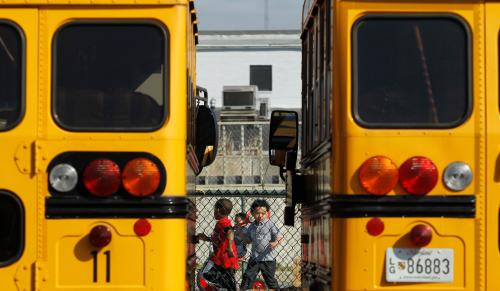Four-day school week schedules are becoming an increasingly common experience for America’s rural youth. These schedules typically involve increasing the length of the school day four days per week and “dropping” the fifth day. In the spring before the COVID-19 pandemic, 662 districts were using the schedule across 24 states, an increase of over 600% since 1999.
During the pandemic, many additional schools in both rural and non-rural areas adopted alternative school schedules, such as the four-day school week. These schedules generally altered the amounts and proportions of synchronous (in-seat) and asynchronous (at-home) learning students received. School administrators have described the pandemic as a “catalyst” for necessary innovations to school schedules and in-seat learning time.
Most of these changes were unprecedented, and their effects on students’ learning and well-being beyond the pandemic remain largely unknown. However, emergent research on the four-day school week may allow us to better assess its effectiveness as a school model in post-pandemic educational policy.
Recent survey findings show that four-day school weeks have been adopted as a way to alleviate budgetary issues, attract teachers, and reduce student absences—issues that the pandemic exacerbated for many districts. Although conditions may be ripe for more schools to turn to such a model in the wake of the pandemic, the research suggests that most of these aims fail to be realized.
Here, we describe the key takeaways from this emerging body of evidence.
Shorter weeks may attract teachers, but don’t expect major cost savings or attendance gains
National and state-specific research finds minimal impacts of the four-day school week on overall cost savings, but it suggests that four-day school weeks may allow school districts greater resource flexibility in the wake of budget shortfalls. The four-day school week may also be used as a form of non-monetary compensation to facilitate instructional cost reductions, as research finds that teachers generally prefer it.
In terms of student attendance, the research to date finds minimal impacts on measures of recorded daily attendance. However, some educators reason that that the four-day week could improve attendance in more nuanced ways undetected by traditional measures of attendance. Most notably, the schedule could decrease the class time that rural students miss for lengthy travel to appointments or extracurricular activities by shifting many of these activities to the off-day.
Maintaining instructional time key for mitigating academic harm
A key concern surrounding the four-day school week is the impact on students’ academic progress. While the evidence regarding overall student achievement impacts is mixed, recent evidence has found primarily negative achievement impacts of four-day school weeks in Oklahoma and Oregon. This has led to a prevailing perception that four-day school weeks are bad for student achievement, a sentiment that was articulated in a recent Education Next piece on the Oregon study. However, the Oregon four-day school week experience is hardly the norm. A more nuanced take of the evidence would suggest that the effects on achievement may depend on whether instructional time stays mostly intact.
In the Oregon study, for example, the stark reductions in math and reading achievement were associated with reductions of three to four hours in weekly time in school. Recent national evidence also suggests that the schools where four-day weeks led to reductions in learning time see the most negative outcomes on student academic progress, with little to no impact on achievement among schools that maintain adequate learning time. Thus, structuring the four-day school week to maintain adequate learning time seems to be the key to avoiding student learning loss and presents a path forward for schools considering this schedule.
Across the country, students on four-day weeks spend about 85 fewer hours per year at school. Some of that time is likely to be lost instructional time, but a portion of it is also non-instructional time, like lunch, recess, and hallway passing time. It’s theoretically possible for a district to maintain its instructional time if it sufficiently extends its school days and reduces the proportion of time spent on non-instructional activities. But in practice, the schedule changes we observe show most schools are reducing instructional time to facilitate the switch.
Few schools with four-day weeks have historically provided any in-school or asynchronous learning opportunities on the off-day. Approximately 50% of schools report being completely closed and only 30% offered any sort of remedial or enrichment activities with any frequency (e.g., regularly or as-needed).
More to worry about than just achievement losses
Lost exposure to the school environment doesn’t only mean missing in-person academic instruction, but also reduced access to school-meal programs, physical activity opportunities, and structured social interactions with peers, teachers, and administrators. A recent study from Colorado finds mixed evidence on health outcomes in schools using a four-day week, but much more research is needed to understand various potential impacts of the schedule on student health.
Worries about child care and unsupervised children on the off-day also abound in discussions of four-day school week implementation. Evidence from Colorado suggests that adolescent students may engage in more criminal activity as a result of the off-day, while a multi-state study found that maternal employment and labor market earnings were reduced as a result of the four-day school week. Despite this evidence, much more research is needed to understand the impact of the four-day school week on family dynamics, relationships, and time use.
The future of four-day school weeks
In the wake of the forced educational innovation during the pandemic, many schools will reconsider their schedules, their policies on in-seat learning time, and synchronous versus asynchronous learning. These decisions could have long-term implications for students’ achievement and well-being.
For districts that have adopted or are interested in adopting four-day weeks, offering asynchronous learning on the off-day could be a creative way for districts to maintain instructional time. Asynchronous learning has been a staple of many pandemic-related educational provision options and, while likely inferior to in-person instruction (as the pandemic learning-loss research suggests), it could be seen as a beneficial supplement to regular in-person school instruction in a post-pandemic educational climate. Incorporating at-home, off-day learning could allow school districts to experience the potential benefits of the four-day school week model while helping to mitigate the achievement losses if in-person time in school is to be reduced.
Increased internet infrastructure, especially in rural and remote areas, has facilitated online synchronous and asynchronous instruction during the pandemic. And while there is worry that some of the new infrastructure investment may be temporary, continued long-term investments in connecting remote communities–as suggested in the recent Biden administration’s “American Jobs Plan”–may make at-home learning more feasible in the areas where four-day school weeks have generally been adopted.
If four-day school weeks continue to be implemented nationwide, issues related to shifting the burdens of food provision and child care on the off-day onto families are likely to remain substantial in many areas. However, continuing to expand “grab-and-go meal” programs that have been a staple of school-meal provision during the pandemic could be a promising strategy for providing school meals on the off-day for students on four-day weeks in the future. (The USDA recently extended these programs through the 2022 academic year.) The American Jobs Plan also outlines expansions to child-care infrastructure, potentially paving the way for more off-day child-care options for parents in these four-day school week communities.
For better or for worse, four-day school weeks–once dubbed a “troubling contagion”–appear to be a fixture of the post-pandemic educational landscape. The evidence to date suggests that how schools structure the four-day schedule is a key determinant in this model’s impact on learning outcomes. Minimizing the loss of instructional time appears to be the best chance at avoiding negative results, though more research is needed to understand the full scope of impacts on students, families, and communities. It also remains to be seen whether other educational innovations in the wake of the pandemic–including remote learning opportunities, greater access to meal programs, and off-day child care–will further the effectiveness of the four-day school week in a post-pandemic world.







Commentary
4-day school weeks: Educational innovation or detriment?
Evidence suggests instructional time makes the difference
July 12, 2021